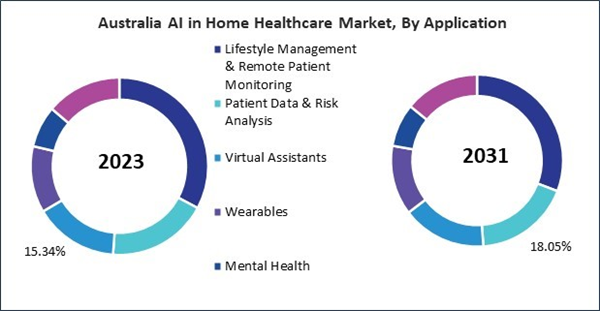The China market dominated the Asia Pacific AI in Home Healthcare Market by Country in 2023, and would continue to be a dominant market till 2031; thereby, achieving a market value of $2,346 million by 2031. The Japan market is registering a CAGR of 53.5% during (2024 - 2031). Additionally, The India market would showcase a CAGR of 55.5% during (2024 - 2031).
Remote monitoring solutions equipped with AI capabilities enable real-time tracking of vital signs, such as heart rate, blood pressure, glucose levels, and oxygen saturation, allowing healthcare providers to detect deviations from baseline values and intervene promptly. These solutions are particularly beneficial for patients with chronic conditions, such as diabetes, hypertension, and heart disease, enabling early intervention and preventing adverse health events.
Moreover, AI-powered virtual assistants and chatbots provide personalized health coaching, medication reminders, and symptom monitoring, empowering patients to take control of their health and adhere to treatment plans. These virtual companions offer round-the-clock support, answer healthcare-related queries, and offer actionable insights based on individual health data, fostering patient engagement and self-management.
In Australia, there's a growing prevalence of chronic diseases due to factors such as an aging population, changes in lifestyle, and advances in medical treatments leading to longer life expectancy. Chronic conditions such as cardiovascular diseases, diabetes, respiratory illnesses, and mental health disorders are becoming more prevalent, placing a significant strain on the healthcare system. As per the data released by the Government of Australia in 2022, eight in ten (81.4%) people had at least one long-term health condition. 49.9% of the population, or one in two, had at least one chronic illness. Hence, the increasing prevalence of chronic diseases and rising telemedicine sector in Asia Pacific will propel the growth of the regional market.
Based on Offering, the market is segmented into Software (Application Programming Interface and Machine Learning Framework), Hardware and Services. Based on Technology, the market is segmented into Machine Learning, Natural Language Processing, Context-aware Computing, and Computer Vision. Based on Application, the market is segmented into Lifestyle Management & Remote Patient Monitoring, Patient Data & Risk Analysis, Virtual Assistants, Wearables, Mental Health and Others. Based on End User, the market is segmented into Healthcare Providers, Healthcare Payers, Patients, and Others. Based on countries, the market is segmented into China, Japan, India, South Korea, Australia, Malaysia, and Rest of Asia Pacific.
List of Key Companies Profiled
- Siemens Healthineers AG (Siemens AG)
- F.Hoffmann-La Roche Ltd.
- GE HealthCare Technologies, Inc.
- Oracle Corporation (Cerner Corporation)
- Koninklijke Philips N.V
- Merative L.P. (Francisco Partners)
- Medtronic PLC
- Sensely, Inc.
- CarePredict Inc.
- Qventus Inc.
Market Report Segmentation
By Offering- Software
- Application Programming Interface
- Machine Learning Framework
- Hardware
- Services
- Machine Learning
- Natural Language Processing
- Context-aware Computing
- Computer Vision
- Lifestyle Management & Remote Patient Monitoring
- Patient Data & Risk Analysis
- Virtual Assistants
- Wearables
- Mental Health
- Others
- Healthcare Providers
- Healthcare Payers
- Patients
- Others
- China
- Japan
- India
- South Korea
- Australia
- Malaysia
- Rest of Asia Pacific
Table of Contents
Companies Mentioned
- Siemens Healthineers AG (Siemens AG)
- F. Hoffmann-La Roche Ltd.
- GE HealthCare Technologies, Inc.
- Oracle Corporation (Cerner Corporation)
- Koninklijke Philips N.V
- Merative L.P. (Francisco Partners)
- Medtronic PLC
- Sensely, Inc.
- CarePredict Inc.
- Qventus Inc.









